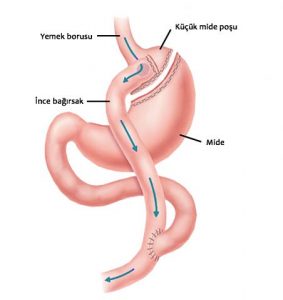
Gastric By-Pass was the gold standard procedure before sleeve gastrectomy. This procedure consists of two phases. First, a portion of the stomach is cut off, so as to create a volume of 30-40 ml. Then, the small intestine is divided from a certain point, and the lover and is connected to the reduced stomach. The remaining portion of the intestine is connected to the small intestine again at a lower point. Thus, the volume of the stomach is reduced so as to enable patients to reach the feeling of satiety by eating less amount of food; and on the other hand, foods are ensured to By-Pass a certain portion of the small intestine so as to reduce intestinal absorption. The gastric acid and digestive enzymes required for the digestion of foods come together at a lower part of the small intestine. Thus, less amount of caloric intake is ensured by enabling patients to feel satiety with smaller serving sizes. With the stimulated digestive hormones, it shows a therapeutic effect on the blood sugar.
Its Advantages:
- The rate of getting rid of excess weight in the long term ranges from 60 to 80%.
- Since the stomach capacity is reduced, the feeling of satiety is ensured by eating very small amount of food.
- It provides many benefits such as triggering various digestive hormones; suppressing the hunger, and improving diabetes.
- The rate of getting rid of excess weight and maintaining the new weight in the long term is over 50%.
Its Disadvantages:
- It is a technically more difficult surgical procedure than sleeve gastrectomy, and its complication risk is higher. The greatest handicap in gastric By-Pass surgery is the fact that patients have no option of a new surgery when they regain weight.
- In the long term, it may lead to deficiencies of vitamin B 12, iron, calcium, and folate. Therefore, it requires lifelong vitamin and mineral support.
- The difficulty of accessing the rest of the stomach (the rest of the stomach and the duodenum cannot be accessed by endoscopy inserted through the mouth).
- Internal herniation in the intestines.
- Dumping syndrome (extensive weakness, nausea, and headache after eating).
- Marginal ulcers (ulcers that occur at the junction of the stomach and intestines may cause perforations).




